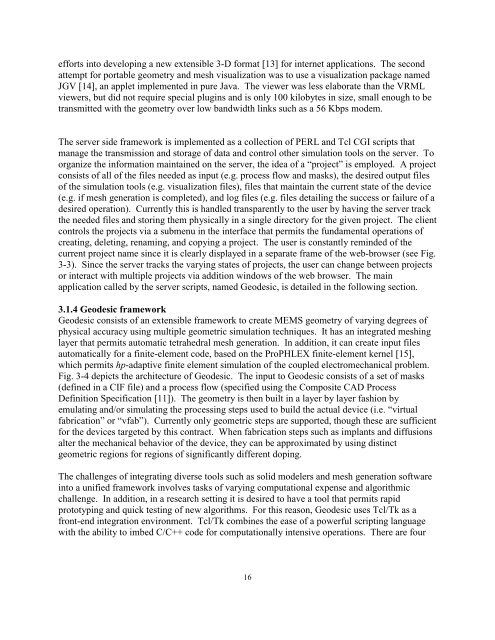Advanced CAD System for Electromagnetic MEMS Interactive Analysis
Advanced CAD System for Electromagnetic MEMS Interactive Analysis
Advanced CAD System for Electromagnetic MEMS Interactive Analysis
Create successful ePaper yourself
Turn your PDF publications into a flip-book with our unique Google optimized e-Paper software.
ef<strong>for</strong>ts into developing a new extensible 3-D <strong>for</strong>mat [13] <strong>for</strong> internet applications. The second<br />
attempt <strong>for</strong> portable geometry and mesh visualization was to use a visualization package named<br />
JGV [14], an applet implemented in pure Java. The viewer was less elaborate than the VRML<br />
viewers, but did not require special plugins and is only 100 kilobytes in size, small enough to be<br />
transmitted with the geometry over low bandwidth links such as a 56 Kbps modem.<br />
The server side framework is implemented as a collection of PERL and Tcl CGI scripts that<br />
manage the transmission and storage of data and control other simulation tools on the server. To<br />
organize the in<strong>for</strong>mation maintained on the server, the idea of a “project” is employed. A project<br />
consists of all of the files needed as input (e.g. process flow and masks), the desired output files<br />
of the simulation tools (e.g. visualization files), files that maintain the current state of the device<br />
(e.g. if mesh generation is completed), and log files (e.g. files detailing the success or failure of a<br />
desired operation). Currently this is handled transparently to the user by having the server track<br />
the needed files and storing them physically in a single directory <strong>for</strong> the given project. The client<br />
controls the projects via a submenu in the interface that permits the fundamental operations of<br />
creating, deleting, renaming, and copying a project. The user is constantly reminded of the<br />
current project name since it is clearly displayed in a separate frame of the web-browser (see Fig.<br />
3-3). Since the server tracks the varying states of projects, the user can change between projects<br />
or interact with multiple projects via addition windows of the web browser. The main<br />
application called by the server scripts, named Geodesic, is detailed in the following section.<br />
3.1.4 Geodesic framework<br />
Geodesic consists of an extensible framework to create <strong>MEMS</strong> geometry of varying degrees of<br />
physical accuracy using multiple geometric simulation techniques. It has an integrated meshing<br />
layer that permits automatic tetrahedral mesh generation. In addition, it can create input files<br />
automatically <strong>for</strong> a finite-element code, based on the ProPHLEX finite-element kernel [15],<br />
which permits hp-adaptive finite element simulation of the coupled electromechanical problem.<br />
Fig. 3-4 depicts the architecture of Geodesic. The input to Geodesic consists of a set of masks<br />
(defined in a CIF file) and a process flow (specified using the Composite <strong>CAD</strong> Process<br />
Definition Specification [11]). The geometry is then built in a layer by layer fashion by<br />
emulating and/or simulating the processing steps used to build the actual device (i.e. “virtual<br />
fabrication” or “vfab”). Currently only geometric steps are supported, though these are sufficient<br />
<strong>for</strong> the devices targeted by this contract. When fabrication steps such as implants and diffusions<br />
alter the mechanical behavior of the device, they can be approximated by using distinct<br />
geometric regions <strong>for</strong> regions of significantly different doping.<br />
The challenges of integrating diverse tools such as solid modelers and mesh generation software<br />
into a unified framework involves tasks of varying computational expense and algorithmic<br />
challenge. In addition, in a research setting it is desired to have a tool that permits rapid<br />
prototyping and quick testing of new algorithms. For this reason, Geodesic uses Tcl/Tk as a<br />
front-end integration environment. Tcl/Tk combines the ease of a powerful scripting language<br />
with the ability to imbed C/C++ code <strong>for</strong> computationally intensive operations. There are four<br />
16
















